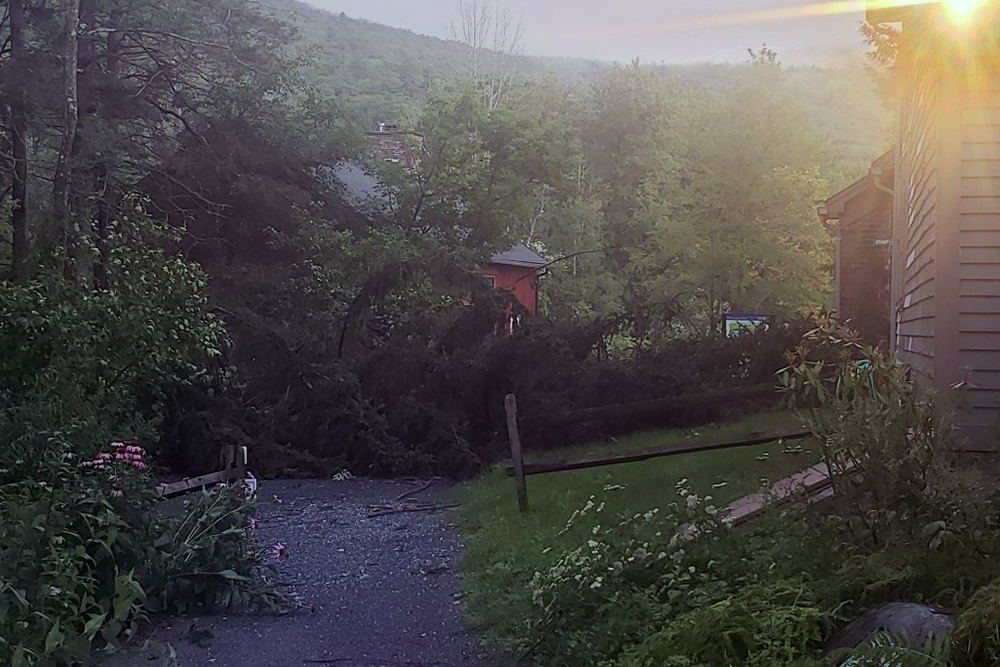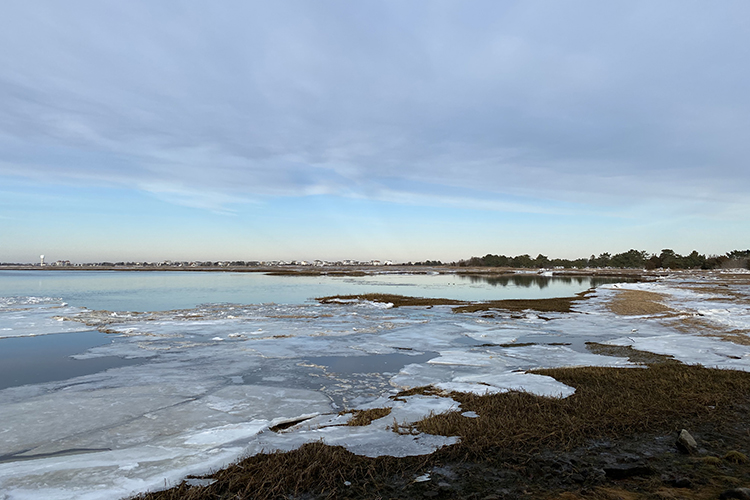Extreme Weather Linked to Climate Change Hits Home
January 01, 2022
And the Role Nature Can Play in Making Our Land More Resilient
When staff arrived for work at Pleasant Valley Wildlife Sanctuary in Lenox on the morning of July 28, 2021, a 40-foot spruce lay across the sanctuary entrance, its upper branches poking through a broken window of the office building. Nearby, dozens of large trees were uprooted, and branches hung precariously overhead.
Looking toward forested Yokun Ridge, one could clearly trace the wide path of destruction—more mature trees were ripped out of the ground and fallen across each other. Perhaps the most heart-wrenching damage was that of the universally accessible boardwalk at Pike’s Pond, part of Pleasant Valley’s All Persons Trail and one of the most beloved spots on the property.
The National Weather Service later confirmed that two passing microbursts had produced 80- to 90-mile-per-hour winds during a thunderstorm the night before. Additionally, nearly an inch of rain fell in a short period of time, drenching an already saturated ground. Around 10 acres of forest trees were windthrown—a substantial disturbance—in this intense event.
Disturbance in Context
Although events like the microburst at Pleasant Valley are jarring, disturbances are a natural part of many ecosystems, and they can actually result in increased habitat diversity. While the forest recovers, however, invasive shrubs and vines can take advantage of the sunlight in newly opened areas and seriously impede forest recovery without intervention. Forest management will be critical to promote the regeneration of native trees, prevent the spread of non-native invasives, and ensure resilience in the face of future storm events.
Unfortunately, Pleasant Valley’s story is not unique. Increased frequency of extreme weather events like the summer 2021 storm is linked to a changing climate. While we may not be able to predict when or how a specific site will be affected, we know that large-scale disturbances will eventually occur over time. Building resilience—the ability of an ecosystem to recover from disturbance without a major change in function—is therefore an important management consideration.
Nature as a Solution to Climate Change
Conservationists frequently—and rightly—tout the benefits of "nature-based climate solutions" to mitigate and become more resilient to climate change. Nature-based climate solutions are conservation, restoration, and improved land management actions that reduce risks from climate hazards, such as flooding, heat, and drought.
They can also increase carbon storage or avoid greenhouse gas emissions in forests, wetlands, and grasslands. Investing in nature-based climate solutions now saves communities billions later.
Protecting watersheds to support public water supplies and restoring coastal barrier islands and wetlands to minimize storm damage are two examples of nature-based climate solutions. Anticipating that the frequency and severity of storm events, coastal flooding, and other disturbances will continue to rise along with global temperatures, Mass Audubon’s ecologists are working proactively to identify vulnerabilities in our wildlife sanctuary network and address priority areas.
For example, an assessment showed Allens Pond Wildlife Sanctuary in Dartmouth to be highly vulnerable to the impacts of sea level rise. To prevent the extreme salt marsh loss that is otherwise expected to occur, Mass Audubon and several partners are creating shallow channels or "runnels" in the marsh to drain pools that have formed due to sea level rise and that are causing vegetation die-off. These runnels will allow for the vegetation to regrow and prevent further marsh erosion. We are also managing adjacent uplands so that the salt marsh can migrate inland in response to rising sea levels.
Funding Nature-based Climate Solutions
Building a resilient landscape is a cost-effective way to fight climate change. Yet, nature as a climate solution has been undervalued and under-resourced. That could change due to a once-in-a-generation opportunity.
In the wake of the COVID-19 pandemic, the federal government has distributed billions of dollars to states to invest in their recoveries. Mass Audubon, along with several partners, is urging legislators to use a portion of the American Rescue Plan Act (ARPA) funds to invest in nature. The advocacy effort—known as $1 Billion for Nature & Climate—will highlight the host of public benefits associated with investments in nature, such as emissions reductions, resiliency against the harmful effects of climate change, improved access to nature and recreation, boosting public health, and local economic development.
This article was featured in the Winter 2022 issue of Explore, our quarterly magazine for members.




